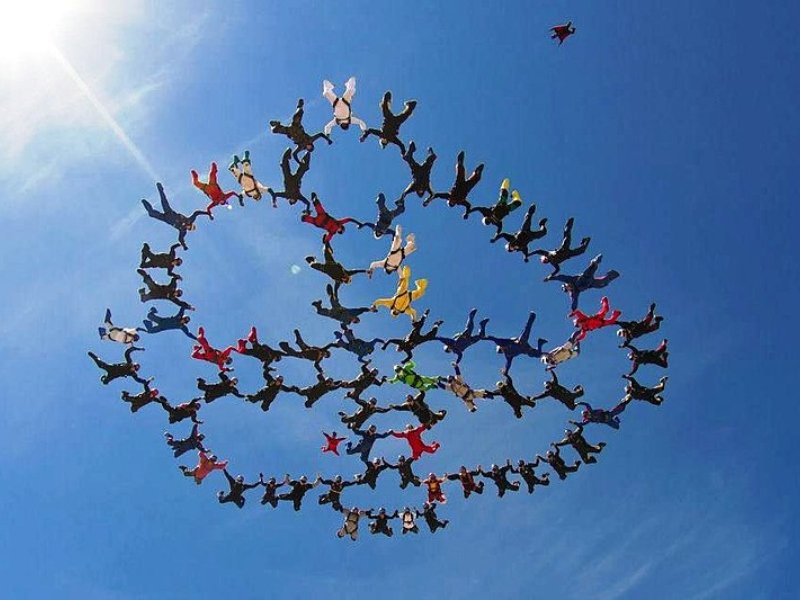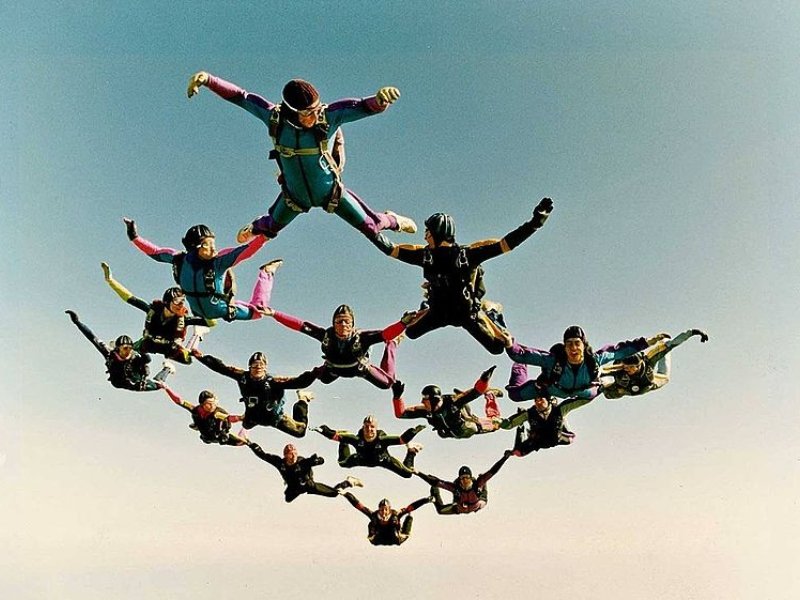You may have heard skydivers talk about formation skydiving and not been sure what it is. Formation skydiving is a fast-growing form of competition skydiving which blends artistic freefall with competitive teamwork. It’s recently grown in popularity, with several formation skydiving courses and coaches now available around the country at all levels.
If you are new to skydiving, formation skydiving is a fun and challenging way to learn new freefall skills and bond with fellow skydivers. You don’t need to have years of experience behind you, and you can take a beginner’s formation skydiving course as soon as you complete your AFF or A license.
Let’s learn more about formation skydiving and how it works. We can look at the different types of competitive formation skydiving and discover how you can get started.
What is formation skydiving?

Formation skydiving is like the freefall equivalent to synchronized swimming. Teams of skydivers (usually 4 or 8 in a group) work together to form artistic formations in the sky. Formations are in the prone position (belly to earth), but some competitions use the vertical position (feet or head pointed to the ground). The competition consists of ten rounds (one round is one jump), and during each round, a team has six set formations to perform. Each round is also timed (35 seconds per round for a 4-way team competition). Each team has a videographer who films everything for the judges.
The teams are all given the same sets of formations picked at random. These formations require each skydiver to get in position and then locking/holding on to each other. The skydivers must be separated before and after each formation. The skydiving videographer also plays a crucial part, as the judges use that material to give out points, with one point for every successful formation. If the weather halts the event, results still stand as long as everyone completes a round.
People also practice formation skydiving for fun. Sometimes referred to as belly flyers, recreational formation skydiving has been around since the 1970s. It’s a great way for regular skydivers to add new elements and fun to skydiving and an excellent bonding exercise. Some organizations have tried to push the record for the most skydivers in one formation, with the current record at 400 skydivers in a single formation!
What types of formation skydiving are there?
There are several different types of formation skydiving, starting with teams of four skydivers, up to big-way formations with no maximum number of skydivers involved. Here are the most common types of formation skydiving:
4-way/8-way/16-way sequential: This is the most common type of formation skydiving, with teams of four, eight, or 16 skydivers creating formations in the prone (belly-to-earth) positions. Each team will perform up to six rounds (skydives) in a day, with competitions lasting 2-3 days and usually ten rounds. Each team has a set time to complete six formations in a round (35 seconds for 4-way and 50 seconds for 8/16-way).
4-way vertical sequential (VFS, Vertical Formation Skydiving): In this category of formation skydiving, the teams perform formations in the head or feet to earth position. Due to the positioning, the skydivers are falling at a much faster speed.
10-way speed: In this type of formation skydiving, teams must complete a formation as quickly as possible (judged on their time rather than how many points). The skydive starts at 11,000 feet. The time begins when the first skydiver crosses the line and finishes when the formation is complete. The teams must complete the formation within 35 seconds, and formations must be held for 5 seconds.
Large formations (Big-ways): Big-way formation skydiving is where a large group of skydivers come together to perform a formation. It’s usually more of a fun event and not competitive, although it is often done to break a local or world record. There is no official number that makes a skydive a big-way. However, it should be more than 6, with more serious big-way events having 100+ skydivers in a single formation.
Formation Skydiving Competition

Formation skydiving is the most popular form of competitive skydiving in the USA. Its popularity is partly down to its safety and accessibility for skydivers of all levels. There are now many regional formation skydiving leagues and teams, as well as national and international tournaments. The best teams from around the country come together for the National Skydiving League Championships and the U.S. National Championships. And the best teams in the world compete at the World Cup and World Air Games.
The International Olympic Committee (IOC) now recognizes many national and international formation skydiving tournaments. There is genuine optimism that it will soon become an Olympic sport. The U.S. and French national teams are by far the world leaders in formation skydiving. The U.S. and France have consistently won every world event in 4-way and 8-way, with the very brief exception of Switzerland, which won the world 4-way sequential event in 1983.
The sport has progressed significantly in the last 20 years. While it is a sport that can be practiced and competed at every level, the top formation skydivers now live and train like athletes. In the 1990s, competition leaders would be incredibly proud to score 6 to 8 points in a round; today, the top teams are scoring 30 to 36 points per round.
How the competitions are scored
Let’s use 4-way formation skydiving as an example, seeing as it’s the most common type. In a 4-way FS competition, there will be two types of formations called upon: ‘randoms’ and ‘blocks.’ Randoms are single formations, which means skydivers start all separated and then come together to create the formation. They must separate again to complete the formation move. Blocks consist of two formations with a specifically designated transition; skydivers must complete formation one and then follow the exact transition into formation two.
The transitions between block formations are ‘inters.’ Each inter has a number that instructs the required transition. Examples:
Inter 1 = The group of 4 skydivers must split into two units of two after the first formation. Both units must then turn 270 degrees and then reconnect into formation number two.
Inter 15 = Everyone breaks free from the first formation and does a complete 360 turn. They then reconnect in the second formation.
Every team has the same list of blocks, randoms, and inters. Blocks are worth one point for each formation (so two points total), and randoms are worth one point. There are a total of 22 blocks and 16 randoms.
The teams get a combination of blocks and randoms in a round, worth 5 to 6 points. Teams have 35 seconds per round, but once the routine is complete, they can repeat it as many times as possible within those 35 seconds.
Judges review the footage and award points. The winning team has the most points at the end of the final round (usually round 10).
How to learn Formation skydiving

You don’t need to be an advanced freefall skydiver to learn and participate in formation skydiving. There are now many courses that teach the sport at a foundation or novice level. There are four levels of competition: Rookie Class, A-Class, AA Class Intermediate, and AAA Class. AAA is the most advanced and professional. In Rookie Class, teams have less complicated moves to complete.
Beginner formation skydiving classes are for new skydivers who have completed their AFF or A license. There’s no need for any additional experience, just a willingness to have fun and learn. Beginner’s training might often start in the wind tunnels where it’s easier to understand basic positioning and transitions. When you head to the skies, you will begin in teams of three or four, and as well as learning your first set of basic formations, you’ll also learn invaluable freefall techniques and rack up more solo dives.
The Benefits of formation skydiving
Formation skydiving has quickly grown in popularity in recent years due to its accessibility to amateur skydivers. Once a skydiver has completed their introductory training course, they are already able to participate and learn formation skydiving. It’s a great skill to learn between your A and B license progression and an excellent tool for bonding with other skydivers.
Skydiving is all about community and friendship, and nothing captures that spirit more than skydivers working together on formations. Formation skydiving is also an excellent way to fast-track your skills. You will learn something with every skydive you do, and in FS your progress is more clearly measured. As you learn and master different moves, you’ll get a great sense of achievement and skill progression. You’ll also grow as a team, and the more you practice and compete together, you will soon begin to push yourselves and try to improve your performance and scores each time. It’s a gratifying sport.
You’ll also find you can soon progress up the levels. Starting at Rookie Class, you will have a lot of fun and learn the ropes, and soon enough, you’ll want to take things more seriously and compete at A Class. Many skydivers who start having fun as a Rookie soon go to A, AA, and even compete professionally at AAA Class. If you develop a talent and passion for the sport, there’s no reason why you can’t go all the way to the top!
Tips for beginners

One of the first tips for forming skydiving is knowing your level and jumping with skydivers of a similar ability. If you are a novice, you may be overwhelmed by participating at A Class, or if you are an AA Class skydiver, you probably won’t gain much by dropping down to Rookie or A Class; unless you want to mentor others. Formation skydiving with similarly skilled and experienced jumpers allows you to all get on the same page and progress together. It really is a great team sport, and you’ll find yourself supporting each other and quickly improving.
Pay attention in the planning and mock-up stages, and make sure everyone is happy and comfortable before you enter the plane. That includes ensuring everyone knows where to sit and when to exit and agrees on the landing order and landing pattern. Once you hit the skies, there isn’t any time left to talk, and if someone is out of whack or confused, it can spoil the entire jump. Everyone makes mistakes and has a bad day, but it’s important to know what to do or ask if you don’t.
Take time to debrief and chat or socialize after your session. Team bonding is the key to building a great team. Having that extra time to get to know each other and discuss improvements will make a big difference in your subsequent attempts. It will take a while to nail the formations’ approaches, leveling out and gripping correctly. That all comes with practice, but also with excellent bonding and communication. And make sure you are all enjoying it. The best FS teams are ones where everyone is having a great time!
What are the world records?

SkyDive PL Big-Way
Big-Way: The current world record for the largest successful big-way FS was a 400-way formation. It was set on February 8, 2006, in Udon Thani, northern Thailand. It took 5 C-130 Hercules planes to carry all the skydivers, and the jump began at 25,400 feet. The 400 skydivers came together and managed to hold the formation for 4.3 seconds.
4-Way: The most points scored in a single round of 4-way was 62 points. This tally was set by the Belgian team in the 2018 World Meet (during round six).
8-Way: The most points scored in an 8-way round was 33 points (in 50 seconds). This score was by the U.S. team (Golden Knights) in round two of the 2015 Dubai Internation Parachute Championship.

